- Date 2019-02-22
- Hit 2846
In 1942, the three-story stone pagoda at the site of Hwangboksa Temple in Guhwang-dong, Gyeongju was dismantled for restoration. In the process, a sarira reliquary containing two Buddha statues was discovered inside the roof stone of the second story.
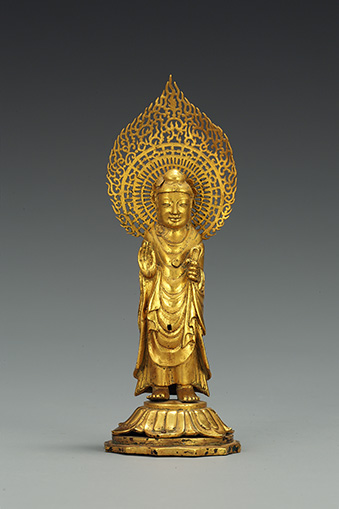 Gold Buddha from Stone Pagoda in Guhwang-dong, Gyeongju, Unified Silla Kingdom (c. 692), Height: 14.0cm, National Treasure 80
Gold Buddha from Stone Pagoda in Guhwang-dong, Gyeongju, Unified Silla Kingdom (c. 692), Height: 14.0cm, National Treasure 80
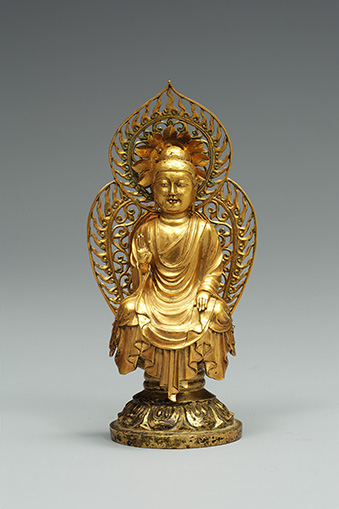 Gold Amitabha Buddha from Stone Pagoda in Guhwang-dong, Gyeongju, Unified Silla Kingdom (c. 706), Height: 12.0cm, National Treasure 79
Gold Amitabha Buddha from Stone Pagoda in Guhwang-dong, Gyeongju, Unified Silla Kingdom (c. 706), Height: 12.0cm, National Treasure 79
The two statues were placed inside a gilt-bronze sarira container with an inscription of 360 Chinese characters (eighteen lines with twenty characters per line) in regular script on the inside of the lid. The exterior sides of the sarira container were also decorated with ninety-nine small pagodas rendered with dotted lines. According to the inscription, when King Sinmun (神文王, r. 681-692) died in 692, Queen Sinmok (神穆太后) and her son, who ascended to the throne as King Hyoso (孝昭王, r. 692-702), erected the three-story stone pagoda at Seonwongaram Temple in honor of the deceased previous kings in the Royal Ancestral Shrine. Then in 706, after Queen Sinmok had died in 700 and King Hyoso had died in 702, King Seongdeok (聖德王, r. 702-737) enshrined four grains of Buddha’s sarira, one pure gold Amitabha Buddha statue with a height of six “chon” (conversion rate for “chon” is imprecise), and the Dharani of the Pure Immaculate Light (無垢淨光大陀羅尼經) inside the second story of the stone pagoda.
 Outer sarira container (left and right) and inner surface of the lid (middle) from the stone pagoda in Guhwang-dong.
Outer sarira container (left and right) and inner surface of the lid (middle) from the stone pagoda in Guhwang-dong.  reliquaries (from left to right): gold case, silver case, gold and silver mounted cups, and glass plate and glass beads from the stone pagoda in Guhwang-dong.
reliquaries (from left to right): gold case, silver case, gold and silver mounted cups, and glass plate and glass beads from the stone pagoda in Guhwang-dong.
At the time of discovery in 1942, researchers found two gold Buddha statues, a gold case, a silver case, gold and silver mounted cups, a glass plate, and glass beads. Although the Dharani of the Pure Immaculate Light was not found, the shapes of the small pagodas depicted with dotted lines on the outer sarira container confirm that the version of the Dharani of the Pure Immaculate Light that was translated into Chinese in 704 had been introduced to the Silla Kingdom.
Production Dates of Statues
The two gold statues are one standing Buddha and one seated Buddha. However, because the inscription does not specify the posture of the statue, it is not clear when or in what order they were produced and installed in the pagoda. However, based on the sculptural style of the two statues, it is estimated that the standing Buddha was installed in 692 when the pagoda was built, and the seated one was installed in 706. The standing Buddha has soft outlines expressing the facial features, with the lips subtly upturned to form a quaint smile. The thick robe covers the entire body, hiding the overall contours, which follows the style of Buddhist sculpture from the preceding Three Kingdoms period (57 BCE-668 CE). As such, the standing Buddha is likely to have been the statue that was installed in the pagoda in 692.
On the other hand, the body of the seated Buddha is realistic and voluptuous, and the creases in the clothing are natural. Also, the outlines of the facial features are quite sharp, matching the style of Unified Silla Buddhist sculpture. The Buddha has one hand raised and the other hand placed on the knee, a hand gesture that was widely associated with Amitabha Buddha in the seventh century. Given that the details of this statue correspond to Unified Silla Buddhist sculpture, influenced by China’s Tang Dynasty, it is estimated to be the Amitabha Buddha statue that was installed in 706.
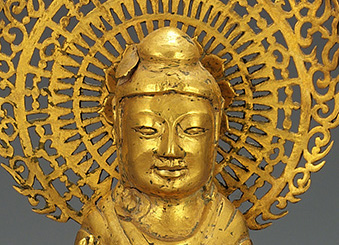 Detail of standing Buddha.
Detail of standing Buddha.
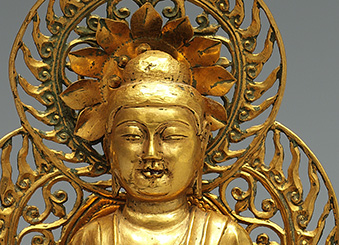 Detail of seated Buddha.
Detail of seated Buddha.
Continuing Tradition and Initiating New Style
On the standing Buddha, the outer robe is wrapped around both shoulders and then thrown back over the left. The creases of the robe are U-shaped. The hands are not very realistic, being rendered larger than normal in proportion to the body. The right hand is raised to show the palm, while the left hand grips the end of the robe. The detail of holding the end of the robe traces back to ancient Mathura or Gandhara Buddhist statues of India, and was also popular in sixth-century Chinese Buddhist statues.
Notably, while the above characteristics reflect the ancient style, the statues also show elements of the contemporaneous sculptural style that was prevalent in the Unified Silla period. For example, the standing Buddha features one of the earliest appearances of U-shaped creases in the robe, a detail that became popular in the Unified Silla period. Standing Buddhas with concentric semi-circular creases rippling down from the waist are said to follow the “Ashoka style.” Such statues are related to the legend in which King Ashoka of India had many Buddhist statues made and shipped to China. In China, most statues with an inscription that reads “King Ashoka” also have U-shaped creases. Although Buddhist statues of Unified Silla did not have such inscriptions, they often featured U-shaped creases.
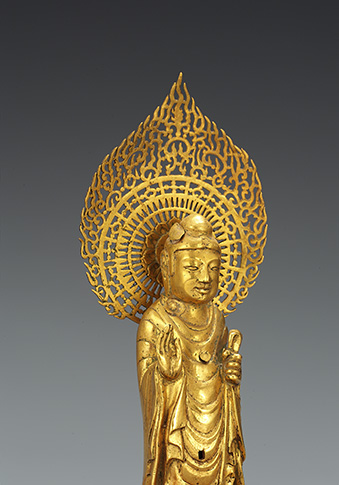 Detail of standing Buddha.
Detail of standing Buddha.
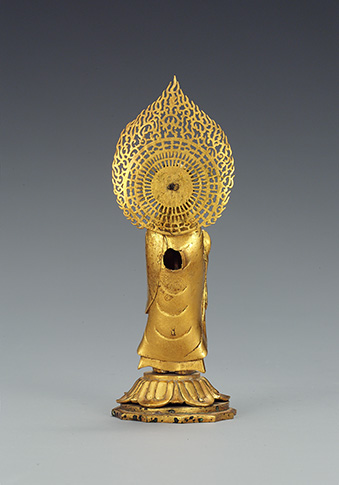 Back of standing Buddha.
Back of standing Buddha.
The ornate halo is delicately cut with two elaborate openwork patterns of blazing flames and concentric circles. A lotus-shaped plate was inserted between the Buddha’s head and the halo, and the pedestal consists of lotus petals on a twelve-sided polygonal support. Various traces of the sculpting process can be found in different areas. For instance, both the head and chest show traces where pegs were placed to hold the mould and the original clay sculpture together, and there is a hole on the back of the Buddha where the original clay sculpture was dug out. The halo, Buddha, and lotus pedestal were separately cast and then joined together.
Receiving and Developing the International Style
The seated Buddha demonstrates how, in the early eighth century, Unified Silla received and developed the sculptural style of China’s Tang Dynasty, which was internationally popular at the time. Compared to the standing Buddha, the seated Buddha has a greater sense of volume and sharper outlines for the facial features, for a more dignified, solemn, and authoritative look. The robe covering both shoulders is thinner and more tightly wrapped, thus revealing the voluptuous contour. The horizontal lines on the neck, symbolizing the three holy paths, have appeared, and other details (such as the lines of the palm) are more meticulously depicted. The expression of the robe cascading down over the lotus pedestal reflects the aesthetics of Tang Buddhist sculpture. Finally, the position of the hands—with the right hand raised to show the palm and the left hand resting on the knee—was a popular symbol of Amitabha Buddha in China. All of these traits clearly show that Unified Silla sculpture was influenced by the Tang Dynasty.
However, the overall expression of the seated Buddha is natural and realistic, eschewing the carnal sensuality and exaggerated three-dimensionality of Chinese Buddhist sculpture, and presaging the peak of Unified Silla Buddhist sculpture represented by Seokguram Grotto.
 Detail of seated Buddha.
Detail of seated Buddha.
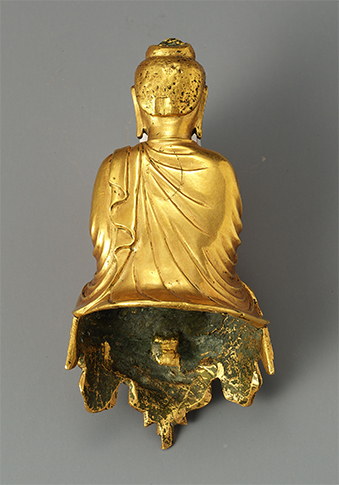 Back of seated Buddha
Back of seated Buddha
 1. Seated Buddha from Stone Pagoda in Guhwang-dong, Unified Silla Kingdom (c. 706), Height: 12.0cm, National Treasure 79
1. Seated Buddha from Stone Pagoda in Guhwang-dong, Unified Silla Kingdom (c. 706), Height: 12.0cm, National Treasure 79
2. Stone Buddha, Tang Dynasty (China, c. 710), Discovered in Fenglingdu, Ruicheng County, Shanxi Province, Height: 93.0cm,
Ruicheng County Museum (© Treasures of Ancient China [中国国宝展], Tokyo: Tokyo National Museum, 2004)
3. Halo and pedestal of the seated Buddha.
As mentioned, the halo, Buddha, and pedestal were produced separately. The halo is composed of two sections, representing light beams emerging from the head and body, respectively. A lotus flower is added to the head halo, while the body halo is decorated with a scroll design. Both halos are elaborately embellished with an openwork scroll and flame design. The pedestal, consisting of three sections, has a unique round form.
There are still some curious details about this Buddha, beginning with its size. Although the inscription clearly states that the enshrined statue had a height of six chon (approximately 20 cm), the height of this statue is slightly less than four chon. Perhaps some future researcher will shed new light on this unresolved issue.
These two gold statues are rare and significant for various reasons: they are early examples of Buddhist statues enshrined in sarira reliquaries; they are made from pure gold and were commissioned and donated by the royal court; they have inscribed dates; and both their halos and pedestals have been preserved intact. Moreover, they exemplify the essence of Unified Silla Buddhist sculpture, continuing the tradition of refined aesthetics and delicate casting techniques while embracing new styles.






 X
X  Facebook
Facebook 